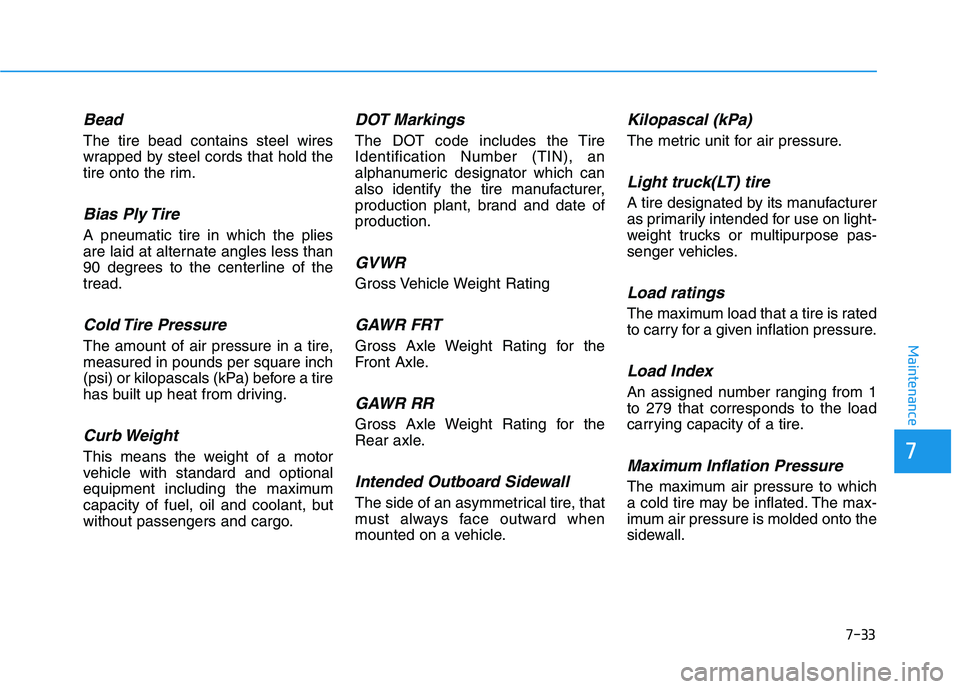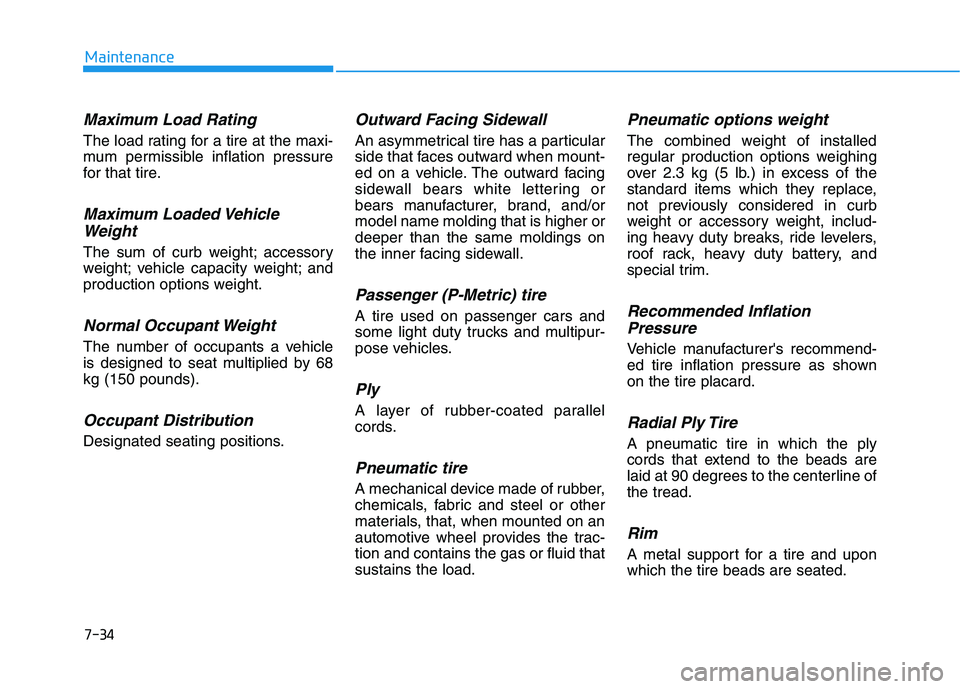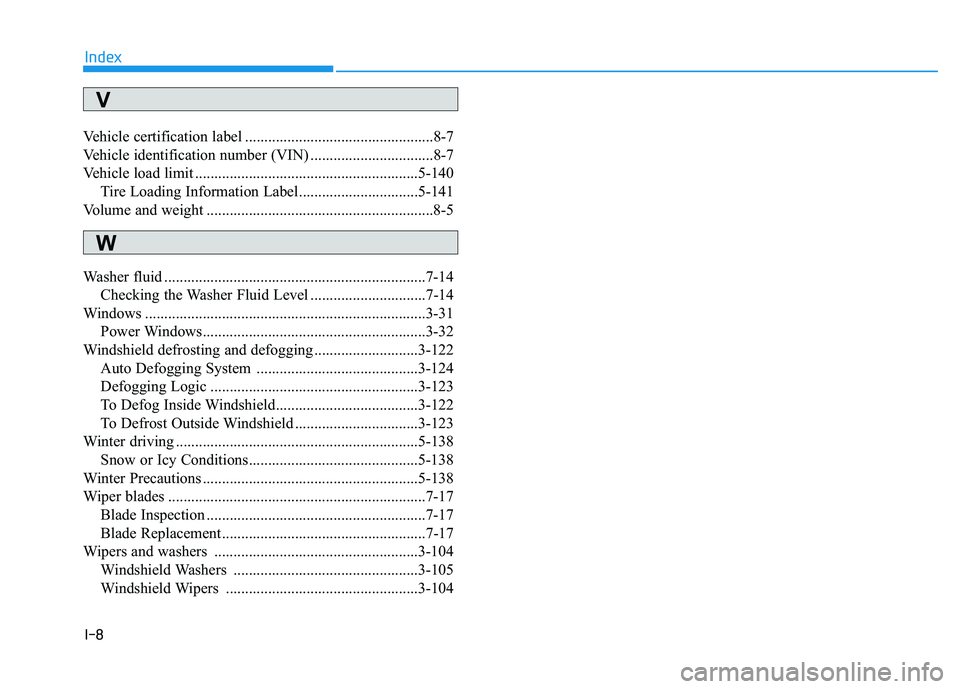Page 492 of 546

7-33
7
Maintenance
Bead
The tire bead contains steel wires
wrapped by steel cords that hold the
tire onto the rim.
Bias Ply Tire
A pneumatic tire in which the plies
are laid at alternate angles less than
90 degrees to the centerline of thetread.
Cold Tire Pressure
The amount of air pressure in a tire,measured in pounds per square inch
(psi) or kilopascals (kPa) before a tire
has built up heat from driving.
Curb Weight
This means the weight of a motor
vehicle with standard and optional
equipment including the maximum
capacity of fuel, oil and coolant, but
without passengers and cargo.
DOT Markings
The DOT code includes the TireIdentification Number (TIN), an
alphanumeric designator which can
also identify the tire manufacturer,
production plant, brand and date ofproduction.
GVWR
Gross Vehicle Weight Rating
GAWR FRT
Gross Axle Weight Rating for the
Front Axle.
GAWR RR
Gross Axle Weight Rating for the
Rear axle.
Intended Outboard Sidewall
The side of an asymmetrical tire, that
must always face outward when
mounted on a vehicle.
Kilopascal (kPa)
The metric unit for air pressure.
Light truck(LT) tire
A tire designated by its manufacturer
as primarily intended for use on light-
weight trucks or multipurpose pas-
senger vehicles.
Load ratings
The maximum load that a tire is rated
to carry for a given inflation pressure.
Load Index
An assigned number ranging from 1to 279 that corresponds to the load
carrying capacity of a tire.
Maximum Inflation Pressure
The maximum air pressure to which
a cold tire may be inflated. The max-
imum air pressure is molded onto the
sidewall.
Page 493 of 546

7-34
Maintenance
Maximum Load Rating
The load rating for a tire at the maxi-
mum permissible inflation pressure
for that tire.
Maximum Loaded VehicleWeight
The sum of curb weight; accessory
weight; vehicle capacity weight; and
production options weight.
Normal Occupant Weight
The number of occupants a vehicle
is designed to seat multiplied by 68kg (150 pounds).
Occupant Distribution
Designated seating positions.
Outward Facing Sidewall
An asymmetrical tire has a particular
side that faces outward when mount-
ed on a vehicle. The outward facing
sidewall bears white lettering or
bears manufacturer, brand, and/ormodel name molding that is higher ordeeper than the same moldings on
the inner facing sidewall.
Passenger (P-Metric) tire
A tire used on passenger cars and
some light duty trucks and multipur-
pose vehicles.
Ply
A layer of rubber-coated parallel
cords.
Pneumatic tire
A mechanical device made of rubber,
chemicals, fabric and steel or other
materials, that, when mounted on an
automotive wheel provides the trac-tion and contains the gas or fluid thatsustains the load.
Pneumatic options weight
The combined weight of installed
regular production options weighing
over 2.3 kg (5 lb.) in excess of the
standard items which they replace,
not previously considered in curb
weight or accessory weight, includ-
ing heavy duty breaks, ride levelers,
roof rack, heavy duty battery, and
special trim.
Recommended InflationPressure
Vehicle manufacturer's recommend-
ed tire inflation pressure as shownon the tire placard.
Radial Ply Tire
A pneumatic tire in which the ply
cords that extend to the beads are
laid at 90 degrees to the centerline ofthe tread.
Rim
A metal support for a tire and uponwhich the tire beads are seated.
Page 494 of 546

7-35
7
Maintenance
Sidewall
The portion of a tire between the tread and the bead.
Speed Rating
An alphanumeric code assigned to a
tire indicating the maximum speed at
which a tire can operate.
Traction
The friction between the tire and the
road surface. The amount of grip pro-vided.
Tread
The portion of a tire that comes intocontact with the road.
Treadwear Indicators
Narrow bands, sometimes called
"wear bars", that show across thetread of a tire when only 1.6 mm
(1/16 inch) of tread remains.
UTQGS
Uniform Tire Quality Grading
Standards is a tire information sys-
tem that provides consumers with
ratings for a tire's traction, tempera-
ture and treadwear. Ratings are
determined by tire manufacturers
using government testing proce-
dures. The ratings are molded into
the sidewall of the tire.
Vehicle Capacity Weight
The number of designated seating
positions multiplied by 68 kg (150
lbs.) plus the rated cargo and lug-gage load.
Vehicle Maximum Load on theTire
Load on an individual tire due to curb
and accessory weight plus maximum
occupant and cargo weight.
Vehicle Normal Load on the Tire
Load on an individual tire that is
determined by distributing to each
axle its share of the curb weight,
accessory weight, and normal occu-
pant weight and dividing by 2.
Vehicle Placard
A label permanently attached to a
vehicle showing the original equip-
ment tire size and recommended
inflation pressure.
Page 531 of 546
888
Specifications & Consumer information
8
Specifications & Consumer information
8
Dimensions ..............................................................8-2
Electric vehicle specifications..............................8-2
Bulb wattage ...........................................................8-3
Tires and wheels ....................................................8-4
Volume and weight ................................................8-5
Air conditioning system ........................................8-5
Recommended lubricants and capacities ...........8-6
Vehicle identification number (VIN) ....................8-7
Vehicle certification label .....................................8-7
Tire specification and pressure label .................8-8
Motor number.........................................................8-8
Page 535 of 546
8-5
88
Specifications & Consumer information
VVOO LLUU MM EE AA NN DD WW EEIIGG HH TT
A
A IIRR CC OO NNDDIITT IIOO NNIINN GG SS YY SSTT EEMM
Contact an authorized HYUNDAI dealer for more details.
ItemsWeight of VolumeClassification
Refrigerant
g (oz.) without heat pump550±25 (19.40±0.88)R-134awith heat pump1,100±25 (38.80±0.88)
Compressor lubricant cc (oz.)180±10 (6.34±0.35)POE
Gross Vehicle Weight kg (lbs.)Luggage Volumel(cu ft)
1,970 (4,343)650 (23.8)
Page 546 of 546

I-8
Vehicle certification label .................................................8-7
Vehicle identification number (VIN) ................................8-7
Vehicle load limit ..........................................................5-140
Tire Loading Information Label...............................5-141
Volume and weight ...........................................................8-5
Washer fluid ....................................................................7-14 Checking the Washer Fluid Level ..............................7-14
Windows .........................................................................3-31
Power Windows..........................................................3-32
Windshield defrosting and defogging ...........................3-122
Auto Defogging System ..........................................3-124
Defogging Logic ......................................................3-123
To Defog Inside Windshield.....................................3-122
To Defrost Outside Windshield ................................3-123
Winter driving ...............................................................5-138 Snow or Icy Conditions............................................5-138
Winter Precautions ........................................................5-138
Wiper blades ...................................................................7-17 Blade Inspection .........................................................7-17
Blade Replacement .....................................................7-17
Wipers and washers .....................................................3-104
Windshield Washers ................................................3-105
Windshield Wipers ..................................................3-104
Index
V
W
Page:
< prev 1-8 9-16 17-24